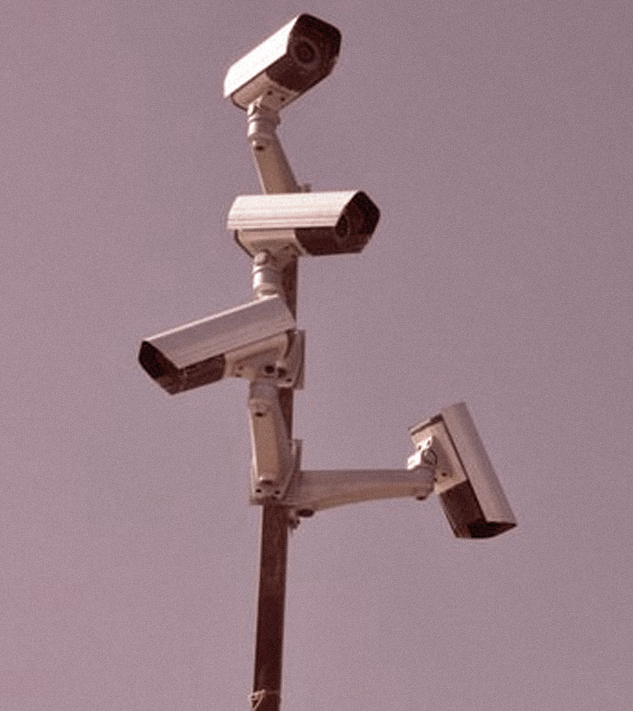How the Pervasiveness of Surveillance is Reflected in Art, Our Society and Ourselves
Words: Arianna Caserta
Make it stand out
Born with parents posting every important moment of their lives on social media, Gen Alpha and their predecessor Gen Z are not attracted to spending their days on the internet. What once was a media landscape ruled by perfect personal feeds and self-branding is now slowly shifting to an internet of ghosts: watching each other age, opaque information, a self-sabotage of our online personas, a constant fear of not choosing wisely enough what we should publish and what we should keep private. In her essay Spam of the Earth: Withdrawal from Representation (2012), visual theorist and artist Hito Steyerl predicted this state of fear, considering how the constant surveillance promoted by phone cameras and CCTV circuits — not to mention, social media, web browsers and apps collecting and selling all of our data — will make people “refuse to constantly be monitored, recorded, identified, photographed, scanned, and taped”. Steyerl added, “Warhol’s prediction that everybody would be world-famous for fifteen minutes had become true long ago. Now, many people want the contrary: to be invisible, if only for fifteen minutes.
With new generations shifting away from the chronically online state promoted by their precursors, it must be true that it’s not easy for them to imagine a cultural shift happening outside of the internet dynamics they were born and raised with. Analyzing how fears and anxieties emerge through visual culture is the only way to explore those cultural shifts: in current times, the rejection of hegemonic systems is strangely intertwined with the way people choose to represent themselves online, blended with aesthetic tendencies and mediated by the visual landscape.
The recent rise of what we refer to as “surveillance aesthetic” is a perfect example of a shared emergency turned into an aesthetic code: little more than a couple of years ago, images of teenagers caught on CCTV cameras in the Paris subway circulated through the web and went viral. “METRO”, the artistic project of art directors duo Kinoproby transformed the anxiety of being filmed by a CCTV camera into an attractive look that would start hundreds of similar experiments. In a similar way, director Moni Haworth created her signature style starting from the pixelated, distant and desaturated look of surveillance cameras, making mechanical eyes merge with her own.
These creatives are layering real life image capturing with the culture of consistent documentation online. They ask: What stage is our relationship with the omnipresent gaze of the internet at? How do we cope with the age of corporate surveillance and its risks? And—most of all—is it really possible to transform our digital age paranoia into an aesthetic current embracing its characteristics?As a response to this cultural climate, many artists have started challenging conventional perceptions of intimacy, voyeurism, and privacy. Italian artist Irene Fenara carries out a visual research on images produced by CCTV cameras which she silently appropriates to snap pictures of herself. “These are mostly cameras belonging to private individuals who do not change the standard security codes, passwords that are always the same and that most of the time very simple, making it very easy for anyone who knows which is the code to gain access: often, it’s just 1234” she tells me, explaining how she preserves those transient images originally intended to remain visible for only 24 hours. By standing in the monitored landscape with her eyes directed into the mechanical eye, Fenara reflects on the “always reversible” relationship between the observer and the observed and transforming that one-way hierarchical relationship in a face-to-face exchange.
To further investigate the way technology has reshaped intimacy, LA based artist Lauren McCarthy transformed herself into a smart home intelligence in her 2017 performance piece LAUREN: “I attempt to become a human version of Amazon Alexa […] The performance begins with the installation of a series of custom designed networked smart devices (including cameras, microphones, switches, door locks, faucets, and other electronic devices). I then remotely watch over the person 24/7 and control all aspects of their home. I aim to be better than an AI, because I can understand people and anticipate their needs” she writes in her artist statement.
”Don’t we all live knowing that a phone camera could suddenly pop up next to our side ready to snap a picture of us, wherever we are?”
For a lot of participants, the unfolding of the performance generated loads of paranoia and overwhelming feelings given by the thought of being observed by a stranger everyday. “It had never occurred to them that by using the devices they normally use in their house, there are potentially many more strangers observing them and collecting data about them,” McCarthy explains.
As if visual culture did not have enough symptoms of the vanishing line between privacy and intimacy, Desktop Cinema has become the new favoured language for scary movies, making us spectators enter into the characters’ private digital environment where someone or something is secretly spying on them. On Instagram, influencers immortalise their own image by embedding it in a play of reflections: Meta Selfies reveal the act itself of taking a picture, capturing one’s look in a self-centred infinity mirror.
Don’t we all live knowing that a phone camera could suddenly pop up next to our side ready to snap a picture of us, wherever we are? It could even be videoing, beside it an Internet personality holding a small microphone to your mouth. And isn’t it true that this has changed how we act in public and how we relate to one another? The pervasiveness of surveillance often makes us forget how we have become accustomed to a life which resembles a perpetual reality show, and if visual aesthetics can become a tool to exorcise our concerns about today’s culture, then let it be our new space to react and counter attack.


